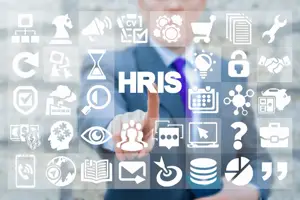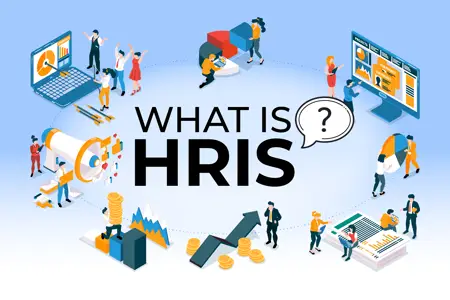Discovering HR Efficiency: Navigating the World of HRIS
An HRIS streamlines essential HR processes such as payroll, time tracking, and benefits administration for companies. Explore the functions and advantages of HRIS with Aniday, and discover the leading options available in the market.
What does HRIS stand for?
An HRIS, or Human Resources Information System, is software that centralizes and automates employee data management and HR processes. It streamlines interactions between employees and their company by eliminating manual tasks and paperwork, enabling HR professionals to focus on strategic work.
The history of HRIS
HRIS systems, initially developed in the 1980s, addressed the administrative demands of HR, a department laden with paperwork and sensitive employee data. Since then, technology has evolved significantly.
Contemporary HRIS solutions automate processes, adapt to rule changes and compliance requirements in real-time, and offer user-friendly, flexible features, making them efficient, powerful, and agile.
Top-tier HRIS software is cloud-based, offering numerous advantages, such as expanded data storage, enhanced security, and seamless integration with complementary applications like payroll, applicant tracking, and other HR systems.
The functions of HR information systems
Leading cloud-based HRIS solutions facilitate a range of HR functions and interactions, offering intelligent automation of workflows throughout the organization, including:
Benefits administration
-
Automated benefits management
-
Self-service features for employees to access, modify, and learn about benefits
Time and attendance
-
Precise handling of employee absences
-
Enhanced administrative efficiency through time profiles for determining employee holidays, work schedules, and premiums
-
Automatic time and pay calculations based on employee profiles

Incorporated Localization
-
Seamless alignment with country-specific business norms and legal regulations, featuring automatic updates for legal and regulatory changes.
-
Extensive catalog of global and local requirements tailored to individual countries.
Employee Self-Services
-
Empower your workforce with self-service functionalities that enhance productivity.
-
Unify HR data within a single platform.
-
Monitor essential HR data in compliance with country-specific mandates.
-
Offer employees personalized profile pages for managing benefits, requesting time off, and more.
Organizational Structures
-
Access real-time analytics for a comprehensive overview of your entire workforce.
-
Identify critical positions and swiftly make workforce adjustments to address any gaps.
-
Visualize your organizational structures efficiently.
Challenges in Implementing Human Resources Systems
Each business is unique and confronts its own set of challenges, which should be effectively addressed by your HRIS. Here are some of the most prevalent HRIS challenges:
Data Privacy and Security
A major concern in HRIS management is safeguarding employee data privacy and security. These systems store vast amounts of sensitive and confidential data that require protection.
A significant challenge is creating a solution that is sophisticated enough to grant each user access to the precise information needed for their tasks while preventing unauthorized access to sensitive data.
Regulations and Compliance
HRIS data access rules must align with regulatory requirements. Organizations must ensure ongoing compliance with constantly changing regulations, which can be particularly demanding for companies with a global presence. Maintaining system usefulness and functionality while adhering to confidentiality and legal requirements is crucial.
Business Disruption
Ongoing HRIS feature changes can also pose challenges. In an era of constant disruptive innovation, organizations may find it challenging to keep up with HRIS updates and enhancements.
Choosing the right HRIS for your business can also be complex, given the multitude of options and features available. It is vital to select a system that aligns with your business objectives and avoid distractions from components that may prove unnecessary.
Advantages of a Cloud-based HRIS System

Beyond the fundamental features of a modern HRIS, cloud-based systems offer enhanced integration capabilities with your existing systems. They are adaptable and can readily incorporate new innovations and security enhancements. Here are several common benefits of an integrated cloud HRIS system:
Accelerates HR Administration
HRIS software, with its capacity to automate and streamline administrative tasks, minimizes delays and errors that often occur with manual and paper-based systems when handling people's livelihoods.
Enhances Employee Experience
HRIS tools enable employees to access their personal information, generate reports, and submit requests directly, eliminating the need to go through the HR department. This improves employees' access to the status of their benefits, payments, and time off.
Boosts Efficiency
Cloud HRIS solutions offer a wide array of self-service tools, reducing the reliance on email and paper-based forms and approval processes. Workflows, schedules, time-off requests, and more can be automated and managed in real time.
Supports Compliance
In an environment marked by remote work and increased legal sensitivity, businesses must ensure their HR activities align with global labor and employment regulations. Cloud HRIS helps maintain compliance and support the workforce.
Enhances Security
HR files contain highly sensitive company data, including employees' medical and financial records. Previously, when stored on laptops or unsecured databases, this data posed cybersecurity risks. Modern integrated HRIS systems come with advanced security protocols to mitigate these risks.

Key Considerations for Selecting the Best HRIS
Customization is essential for tailoring your HRIS to your company's unique needs. However, when choosing an HRIS solution provider, there are two crucial areas of functionality to prioritize:
Comprehensive HR Management
The selected solution should encompass all aspects of HR management, including recruitment, onboarding, learning, succession planning, and HR help desk. It's vital to have access to an all-encompassing, adaptable solution that can evolve with your changing needs. What suits you today may not suffice tomorrow.
Integration with Finance
Labor costs significantly impact any organization's finances. Decisions related to personnel invariably have financial implications. Therefore, complete visibility into both your workforce and financial data, along with their interrelationship, is crucial.
The ideal HRIS should be tightly connected to the finance function, ideally operating on the same platform and technology as the company's financial systems.
HRIS implementation in 6 steps
Step 1: Preparation and Planning
In this crucial initial phase, your company sets the stage for the HRIS implementation. Having already chosen to transition from manual data entry in Excel, it's time to take the next steps:
-
Assemble a project team, consisting of HR professionals and representatives from relevant departments. This ensures comprehensive input from all areas.
-
Define your organization's software requirements. Within the project team, address key questions regarding your HRIS (features, complexity, cloud-base vs on-premise, etc.)
-
Establish a budget for the project, which will guide your software selection in the next stage.
Step 2: Research and Trials
In this step, gather information to finalize your HRIS selection:
-
Research HRIS options that align with your business requirements and features outlined in Step 1. You can search for best-in-class software, issue a request for proposal, or find an HRIS that matches your needs.
-
Create a shortlist of options that meet your business requirements and budget, along with the essential features defined in Step 1.
-
Test the shortlisted contenders with your project team. Stay in touch with vendors to assess their HRIS solutions, ensuring they meet all required functionalities.
Step 3: Installation and Data Migration
After selecting your HRIS solution and conducting initial trials, it's time to proceed with software implementation and data transfer.
-
Work with your chosen provider and team to install the software, staying in touch with the provider for support. Depending on your installation choice (cloud-based or on-premise), your IT department may need to help with setup and configuration.
-
Once the installation is complete, initiate the data transfer. Gather all relevant data from various sources such as software, spreadsheets, and paper records, ensuring accurate recording in your new HRIS.
Step 4: Testing and Training
With the system in place, your team may still need familiarization:
-
Thoroughly test the software to verify correct setup and data integrity. Explore its features and provide training to any remaining project team members unfamiliar with the software.
-
Maintain provider support for issue resolution and clarification of complex features, ensuring a smooth transition.
Step 5: Going Live and System Adoption
Your software is installed, and your company is ready to transition, but there are some important steps remaining:
-
Announce the upcoming software change to all employees, emphasizing the benefits of the new HRIS and its impact on current business processes.
-
Start onboarding employees to the new HRIS. Prioritize key departments and frequent users for training, and ensure everyone has the right security roles for data access.
Step 6: Follow-up, Feedback, and Support
Now, shift your focus to the HRIS's long-term maintenance:
-
Keep an eye on ongoing issues and refinements needed for the HRIS. Consider its scalability and potential software integrations.
-
Maintain training and feedback loops. Offer support for those still facing challenges with the HRIS. Gather user feedback to guide software maintenance and enhancements.
The Top HRIS softwares in 2023 (by Forbes)
Following are the some of the top HRIS systems of 2023 adviced by Forbes
Paycor
Paycor offers a unified platform for small to midsize businesses, encompassing all HR functions, including onboarding, payroll, expenses, and talent development. The employer or HR department can efficiently manage the organizational structure, post company updates, and stay informed about new hires and the onboarding process through the portal.
Monday.com
monday.com, a powerful HRIS, offers ATS, employee onboarding, goal planning, talent management, project management, help desk, reporting, analytics, and seamless integrations with Indeed and LinkedIn. It's the choice of top companies like Hulu and Coca-Cola.
Rippling
Rippling streamlines global people operations, handling everything from onboarding to offboarding in a single platform. With a cutting-edge payroll system, you can pay employees and contractors in minutes, backed by a 100% accuracy guarantee.
BambooHR
HRIS platforms like BambooHR empower HR teams to digitize paperwork, automate manual tasks, and access real-time data from a centralized source, ensuring they make informed decisions based on complete and accurate employee information.
Workday
Workday HRIS is a comprehensive human resources information system with an intuitive interface and intelligent features. It assists organizations in optimizing core finance, HR, planning, and spend management processes, enhancing the efficient management of employee data, and delivering improved user experiences throughout the organization.
Conclusion

The future HRIS will be user-friendly, leveraging AI and ML for intuitive solutions. Back-end improvements will streamline operations and customized upgrades. Organizations adopting these technologies will create a collaborative tech-human workplace, with HR at its core. Aniday hopes this article has provided you an insightful overview about HRIS systems and their relevant information for your references.
Aniday's HR Services
Headhunting Service
Find and recruit quality candidates in just 1 week! Supported by 40,000 experienced headhunters in IT, Finance, Marketing… capable of recruiting in any region.
Headhunting Service ➔Employer of Record (EOR) Service
On behalf of your business, we recruit employees and handle payroll without the need to establish a company in markets such as Vietnam, Singapore, Malaysia, India, Indonesia…
Employer of Record (EOR) Service ➔
